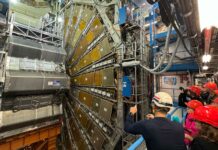In 1999, Massachusetts Institute of Technology (MIT) professor David Miller showed the movie, “Star Wars” to his students on their first day of class. Following the scene where Luke Skywalker spars with a floating droid “remote,” Miller stood up and pointed: “I want you to build me some of those.” So they did. With support from the Department of Defense and NASA, Miller’s undergraduates built five volleyball-sized free-flying satellites called Synchronized Position Hold, Engage, Reorient, Experimental Satellites (SPHERES); three of which have been on the International Space Station since 2006.
In ne le to, SPHERES so opremljeni tudi z Android mobilnim telefonom:
Each SPHERE Satellite is self-contained with power, propulsion, computing and navigation equipment. When Miller’s team first designed the SPHERES, all of their potential uses couldn’t be imagined up front. So, the team built an “expansion port” into each satellite where additional sensors and appendages, such as cameras and wireless power transfer systems, could be added. This is how the Nexus S handset – the SPHERES’ first smartphone upgrade – is going to be attached.
Nexus S is the first commercial smartphone certified by NASA to fly on the space shuttle and to be cleared for use on the space station. The smartphone includes a four-inch touchscreen display, a 1-GHz processor, digital cameras, gyroscopes, accelerometers, proximity and light sensors, Bluetooth and Wi-Fi networking, as well as 16 gigabytes of internal memory. And, as with an increasing number of smartphones, Nexus S uses the open-source Android platform.









